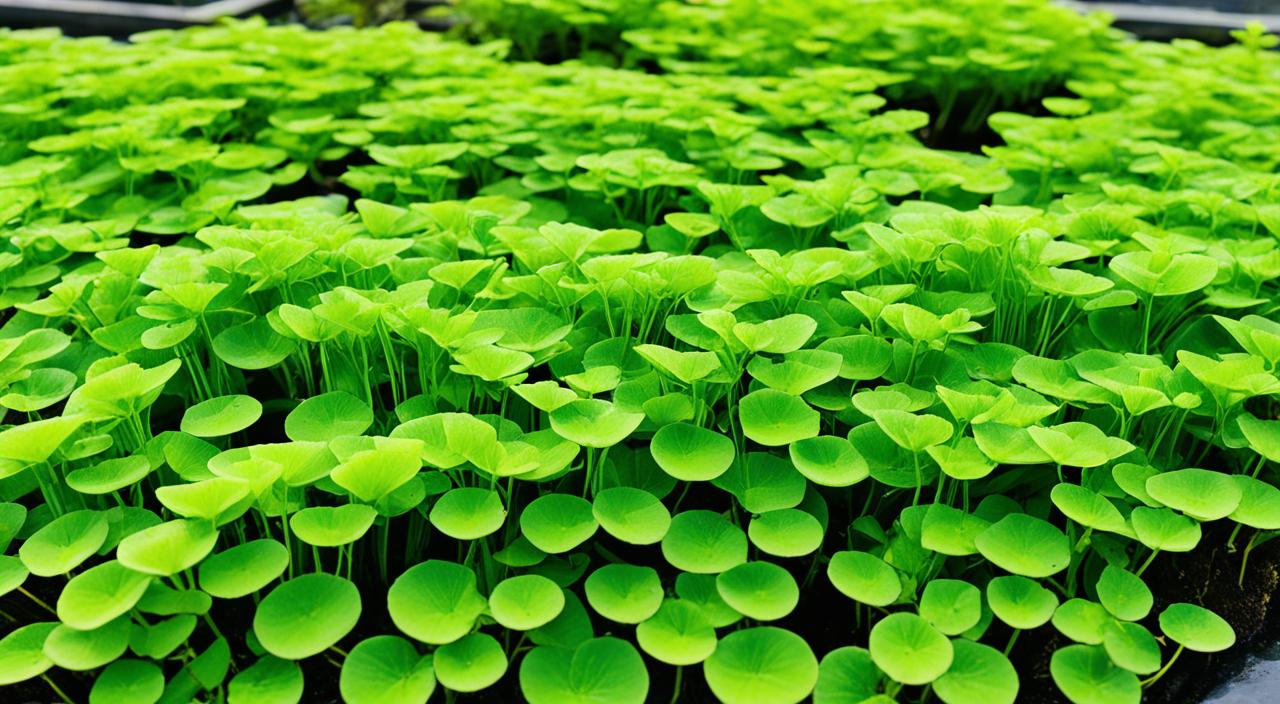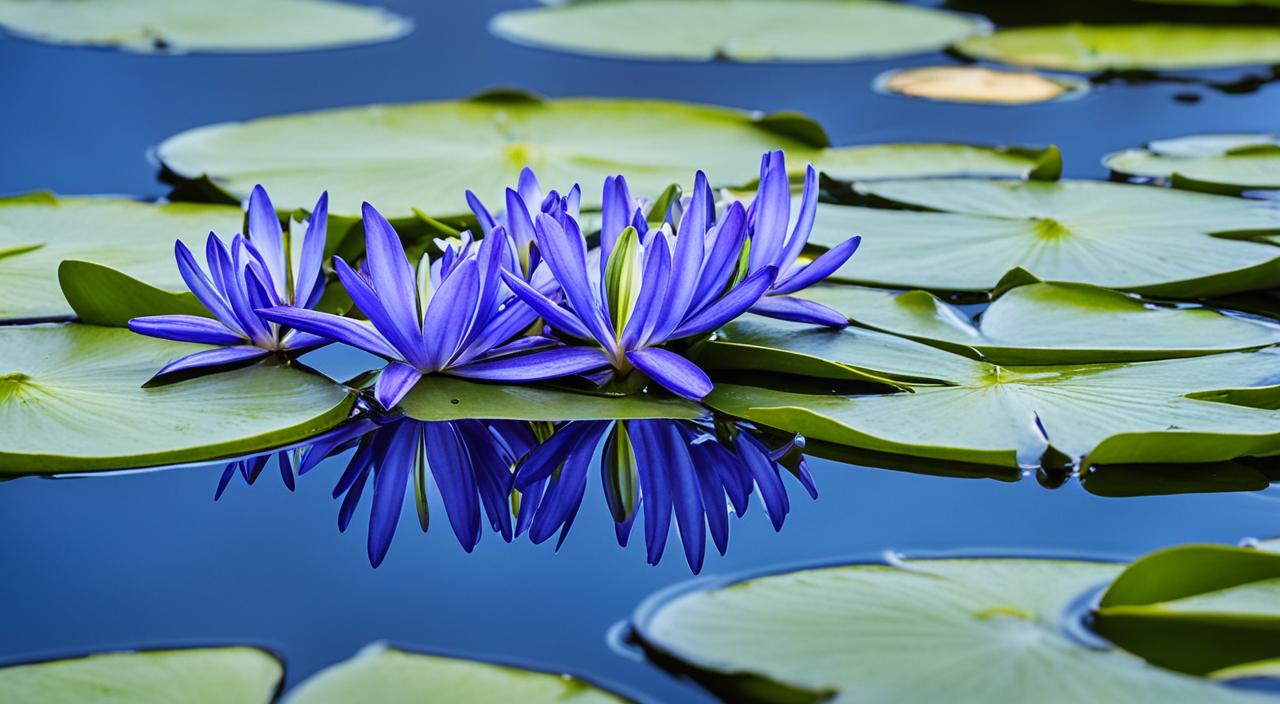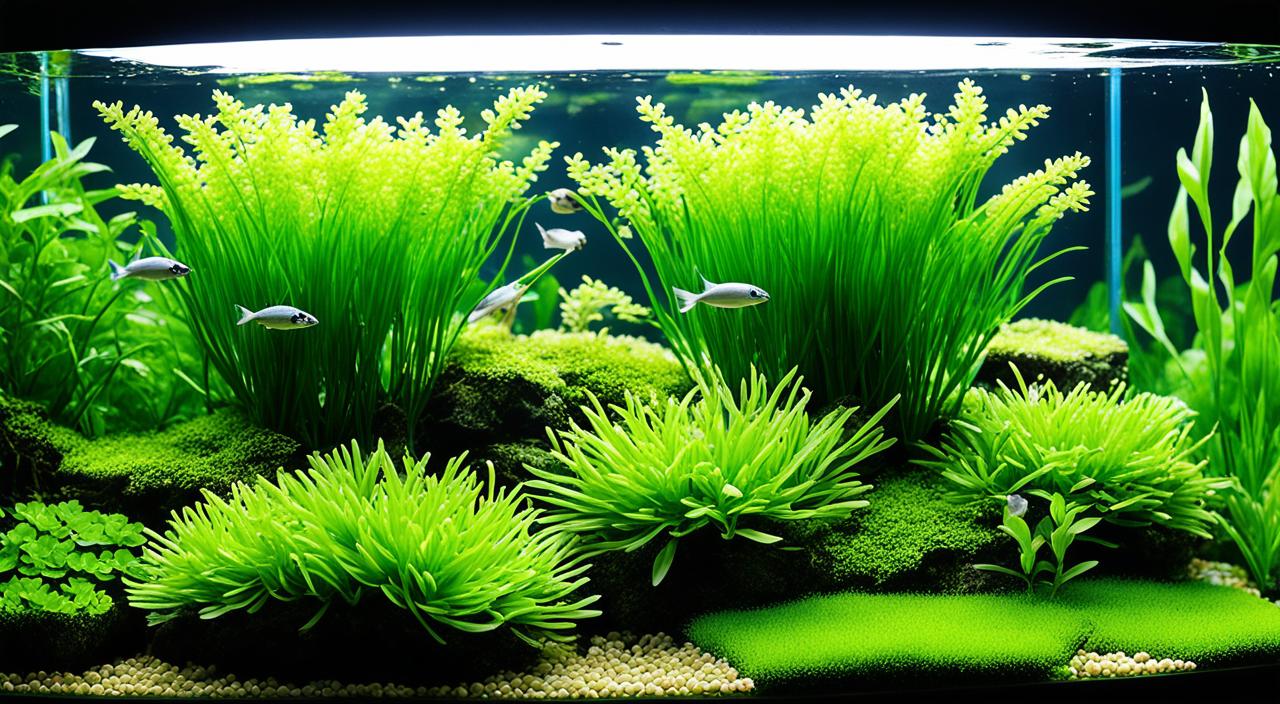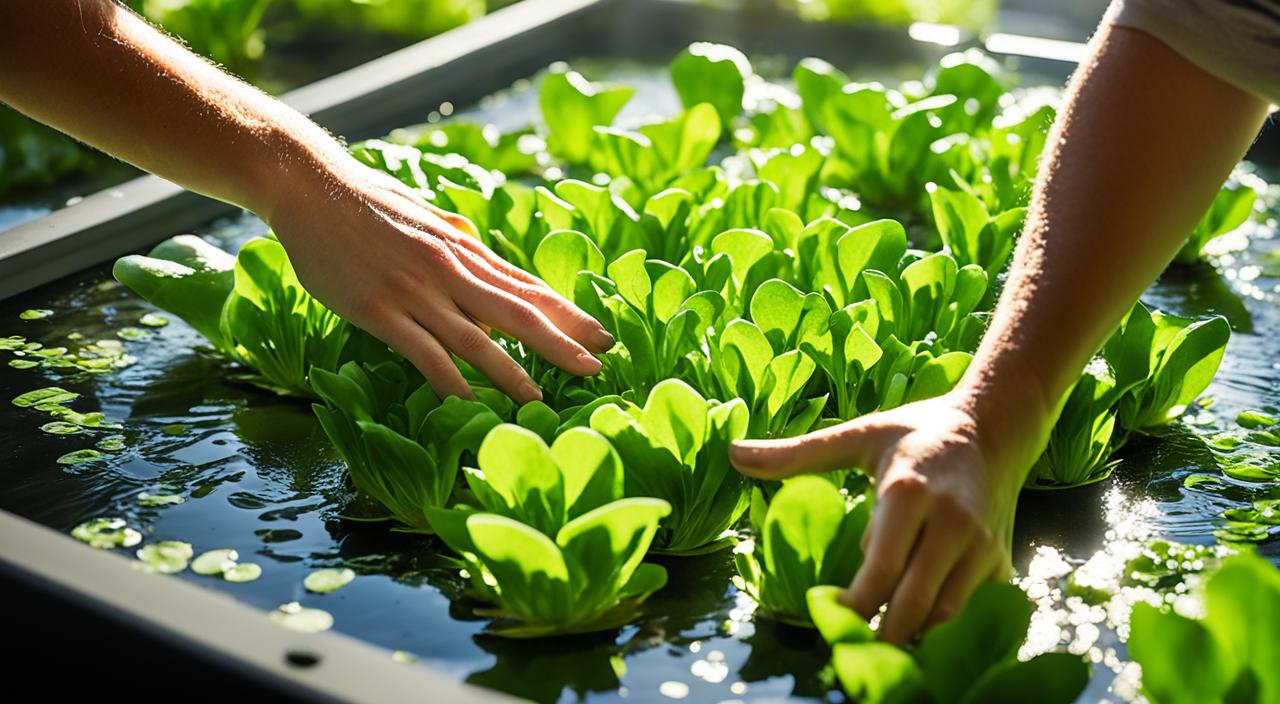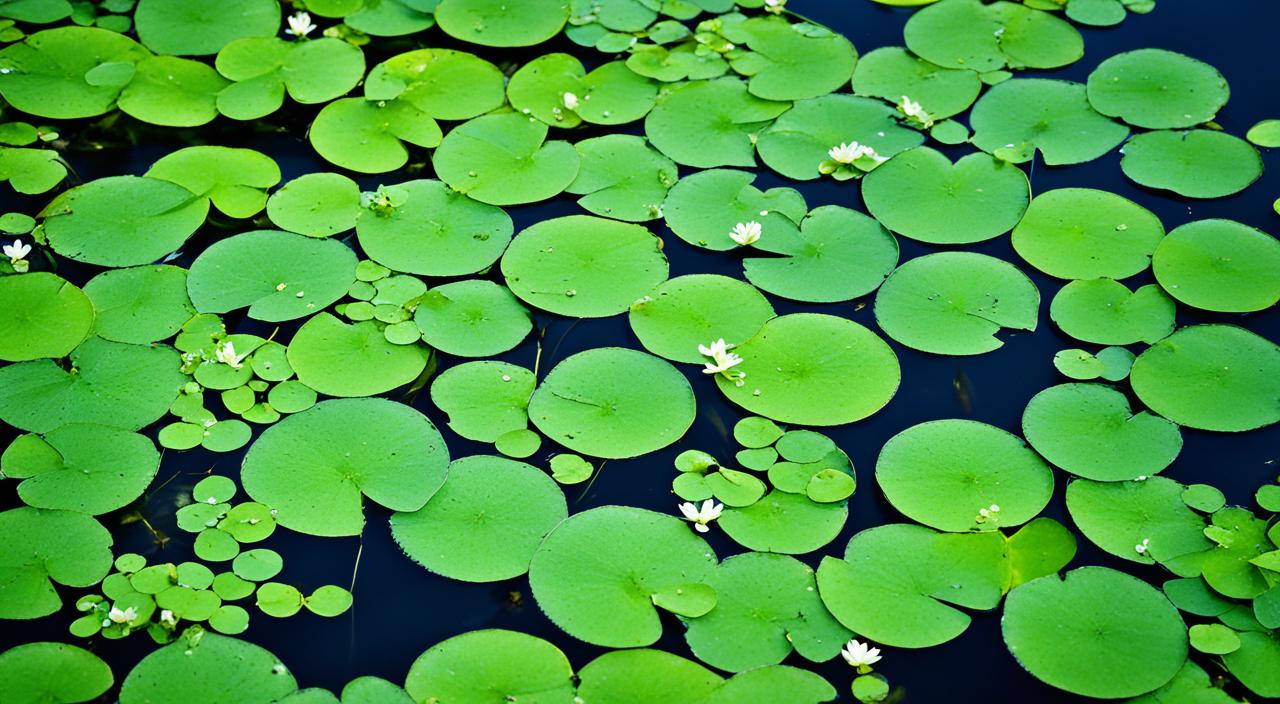Greetings, fellow aquarium enthusiasts! Today, I want to dive deep into the fascinating world of Salvinia, a genus of floating ferns that will add a touch of beauty and functionality to your aquatic haven. Whether you’re a beginner or an experienced hobbyist, this comprehensive Salvinia care guide will equip you with the knowledge and techniques to maintain these intriguing floating aquarium plants.
Salvinia is a versatile plant that enhances the aesthetics of any aquarium, provides valuable surface coverage, and contributes to water quality improvement. Its unique characteristics, such as its ability to absorb CO2 and nitrogen, make it a popular choice among freshwater aquarium ferns. But before we delve into the specifics, let’s learn more about the origins and habitat of Salvinia.
Key Takeaways:
- Salvinia is a genus of floating ferns that adds beauty and functionality to aquariums.
- It provides surface coverage and aids in water quality improvement.
- Salvinia absorbs CO2 and nitrogen, making it ideal for aquaria.
- Understanding its origins and habitat is crucial for successful care.
- Stay tuned for more detailed information in the following sections!
Brief Overview Of Salvinia (Salvinia spp.)
Salvinia is a genus of floating ferns that is highly sought after by aquarium enthusiasts. With its captivating foliage and ability to provide surface coverage, Salvinia is a popular choice for aquarists. Salvinia’s unique morphological characteristics, such as heterospory and distinct leaf development, are what sets it apart from other ferns.
Salvinia has a fascinating reproductive strategy known as heterospory, which produces spores of different sizes. This feature distinguishes Salvinia from other ferns and contributes to its versatility as a floating plant.
Salvinia Species Table:
| Characteristic | Description |
|---|---|
| Scientific Name: | Salvinia spp. |
| Common Names: | Water Spangles, Floating Fern, Floating Moss |
| Origin: | Tropical and subtropical regions worldwide |
| Height: | Not necessary, but it can benefit from CO2 in densely planted tanks |
| Growth Rate: | Fast |
| Colour: | Green fronds, sometimes with a brownish underside |
| Aquarium Placement: | Water surface |
| Water Type: | Freshwater |
| pH: | 6.0 – 7.5 |
| Care Level: | Easy |
| Light Requirements: | Moderate to high. Prefers 50-70 PAR, can thrive under 6500K to 7000K lighting for optimal growth. |
| CO2 Requirements: | Primarily a light feeder, it absorbs nutrients from the water column |
| Temperature: | 18°C – 30°C (64°F – 86°F) |
| Flow Rate: | Low to moderate; prefers still water but can tolerate gentle flow |
| Propagation: | Vegetative, through division of rhizomes |
| Feed Type: | It is not necessary, but it can benefit from CO2 in densely planted tanks |
Regarding light requirements, Salvinia spp. are generally adaptable but perform best under moderate to high lighting conditions. A PAR (Photosynthetically Active Radiation) range of 50-70 is ideal for healthy growth. The Kelvin scale, which measures the colour temperature of light, can also influence growth and health; a range of 6500K to 7000K is often recommended for planted aquariums, providing a balance of light that closely mimics natural daylight and promotes photosynthesis effectively.
Salvinia’s leaf development is also noteworthy. It consists of two types of leaves: floating leaves and submerged leaves. The floating leaves are green, flat, and sessile or short-petioled. They are responsible for providing surface coverage and retaining moisture. On the other hand, the submerged leaves are finely dissected, petiolate, and root-like. These unique leaf structures allow Salvinia to adapt to its aquatic environment and thrive.
To provide optimal care and maintenance for Salvinia in an aquarium setting, it is crucial to understand this genus’s origins and habitat requirements. By considering their natural habitat, aquarists can create an environment that closely mimics the conditions necessary for the healthy growth of Salvinia.
Let’s explore the origins and habitat of Salvinia to gain a better understanding of their care needs.
Origins And Habitat
Salvinia, a genus of freshwater aquarium ferns, is native to various regions across the globe such as North America, Central America, South America, Eurasia, and Africa. These floating ferns are primarily found in aquatic environments like lakes, ponds, rivers, and swamps. Salvinia thrives in both tropical and subtropical regions, preferring still or slow-moving water with high nutrient levels.
It’s important to note that while Salvinia can be a valuable addition to aquariums, some species are considered invasive in the wild. Invasive Salvinia species can form dense mats, displacing native plant species and disrupting the delicate ecological balance of aquatic ecosystems.
| Region | Habitat |
|---|---|
| North America | Lakes, ponds, rivers |
| Central America | Lakes, ponds, rivers |
| South America | Lakes, ponds, rivers, swamps |
| Eurasia | Lakes, ponds, rivers, swamps |
| Africa | Lakes, ponds, rivers, swamps |
Morphological Characteristics
Salvinia, a floating fern genus, displays unique morphological characteristics that distinguish it from other fern species. Salvinia is a floating plant with creeping stems that can densely cover the water’s surface, forming mats that provide numerous benefits in aquariums.
The leaves of Salvinia are arranged in trimerous whorls, consisting of two floating leaves and one submerged leaf. The floating leaves are green, sessile or short-petioled, flat, and smooth-edged. On the other hand, the submerged leaf is finely dissected, petiolate, rootlike, and pendent. An exciting characteristic of Salvinia is that the upper side of the floating leaf, which appears to face the stem axis, is morphologically abaxial. This unique leaf development contributes to Salvinia’s ability to float effortlessly and provide extensive surface coverage in aquariums.
To help visualize the morphological characteristics of Salvinia, refer to the image below:
| Characteristics | Description |
|---|---|
| Arrangement | Leaves are arranged in trimerous whorls |
| Floating Leaves | Green, sessile or short-petioled, flat, and entire |
| Submerged Leaf | Upper side of floating leaf appears to face the stem axis. |
| Leaf Orientation | The upper side of the floating leaf appears to face the stem axis. |
These unique morphological characteristics make Salvinia an attractive and beneficial addition to aquariums, providing aesthetic appeal and functional advantages.
Placement And Lighting
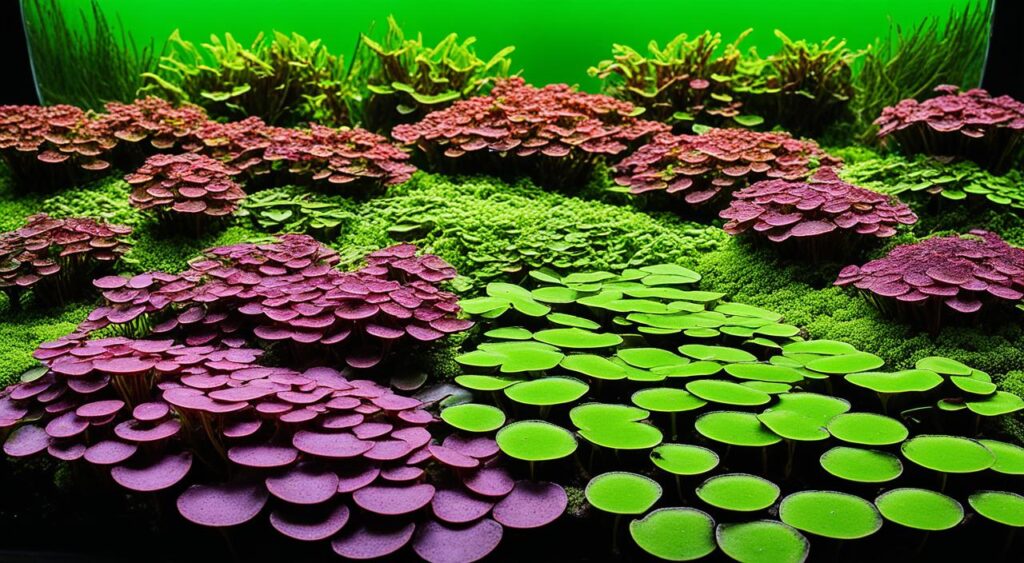
Proper placement and lighting are crucial for the successful cultivation of Salvinia in an aquarium. To ensure optimal growth, Salvinia should be positioned in an area that receives moderate to bright indirect light. Direct sunlight should be avoided as it can lead to excessive algae growth and temperature fluctuations, which may negatively impact the health of the plant.
Salvinia should be allowed to float and spread across the water’s surface as a surface coverage plant. This provides an attractive appearance and offers shade and cover for other aquatic species in the tank. Ensuring that Salvinia has enough space to grow and expand without becoming crowded is essential.
What Are Good Tank Mates?
Salvinia, a versatile floating fern, can coexist harmoniously with various aquatic species in an aquarium. It adds aesthetic appeal to the tank and provides practical benefits such as shelter, breeding grounds, and improved water quality for compatible tank mates.
Good Tank Mates
When choosing good tank mates for Salvinia, it is essential to consider their size, behaviour, and compatibility with the delicate floating foliage. Here are some suitable tank mates:
- Guppies
- Tetras
- Rasboras
- Shrimp
- Snails
These small to medium-sized fish and invertebrates can thrive in the presence of Salvinia, benefiting from the shelter it provides.
Fish Species To Avoid
While many fish species can peacefully coexist with Salvinia, it is crucial to avoid larger fish species that may uproot or damage the delicate floating foliage. Additionally, aggressive or herbivorous fish species should be avoided to prevent them from consuming the Salvinia.
Salvinia Tank Mates
Salvinia is a versatile floating fern that can coexist with various aquatic species in an aquarium. It provides compatible tank mates shelter, breeding grounds, and water quality benefits. Good tank mates for Salvinia include small to medium-sized fish, such as guppies, tetras, and rasboras. Shrimp and snails can also thrive in the presence of Salvinia. However, it is crucial to avoid larger fish species that may uproot or damage the delicate floating foliage. Aggressive or herbivorous fish species should also be avoided to prevent them from consuming the Salvinia.
Feeding (Fertilization)
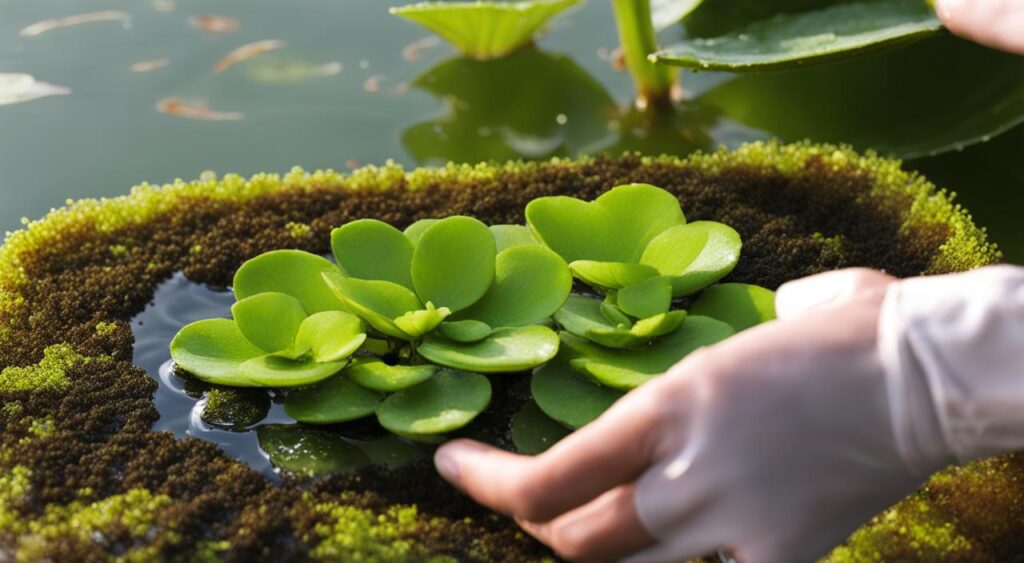
Salvinia, being a floating plant, absorbs nutrients from the water through its roots and leaves. It obtains nutrients from both the water column and the substrate. However, in a well-established aquarium with a balanced ecosystem, additional fertilization may not be necessary. It is essential to monitor the water parameters and provide appropriate nutrition to ensure the health and growth of Salvinia.
Overfeeding the tank can lead to nutrient imbalances and excessive algae growth, harming water quality. It is advisable to feed Salvinia sparingly, providing it with just enough nutrients to thrive.
Proper nutrition can be achieved through a combination of factors:
- Quality fish food: When aquarium inhabitants are fed high-quality fish food, the nutrients from the food will eventually cycle through the water and be available to Salvinia.
- Nutrient-rich water: Maintaining good water quality is crucial for Salvinia’s health. Regular water changes can help replenish essential nutrients in the tank.
- Supplemental fertilization (if necessary): If the aquarium lacks sufficient nutrients, supplements specifically designed for aquatic plants can be used. These supplements usually provide essential macronutrients and micronutrients that may be lacking in the water column.
Salvinia can thrive and contribute to a vibrant and balanced aquatic ecosystem by carefully monitoring the water parameters and following appropriate feeding practices. Remember, balance is crucial, as both underfeeding and overfeeding can adversely affect the overall well-being of the tank.
How Much And How Often To Feed
The feeding frequency and quantity for Salvinia can vary based on the specific needs of your aquarium. It is generally recommended to feed sparingly, avoiding excessive amounts that could lead to nutrient imbalances and water quality issues.
Observing Salvinia’s behaviour and growth can help determine whether you provide enough nutrients. If the plants are healthy and displaying vibrant green foliage, it is a good indication that they are receiving sufficient nutrition. If the plants start to show signs of yellowing or stunted growth, it may be a sign that they require more nutrients.
As a general guideline, feeding Salvinia 2-3 times a week is often sufficient. Start with small amounts and observe how the plants respond. Adjust the feeding frequency and quantity as needed based on your aquarium’s specific conditions and requirements.
CO2 Injection
CO2 injection is an effective method to enhance the growth of Salvinia in an aquarium. Providing an additional source of carbon dioxide is essential for photosynthesis, promoting healthy plant growth and development. Different types of CO2 injection methods are available, each with its own benefits and considerations.
One standard method is the DIY yeast reactor, where yeast is used to produce carbon dioxide by fermenting sugar. This method is affordable and easily accessible for aquarium hobbyists. However, frequent maintenance and monitoring may be required to ensure consistent CO2 production.
Another popular option is using CO2 canisters with regulators. These canisters contain pressurized carbon dioxide that can be controlled and released into the aquarium. This method provides more precise control over CO2 levels and is suitable for larger aquarium setups. However, it requires an initial investment in equipment and regular refills of the CO2 canister.
Liquid carbon supplements are also available as an alternative to gas injection methods. These supplements contain liquid formulas with carbon compounds that can be easily dosed into the aquarium. While they provide carbon dioxide for plants, they may not be as effective as gas injection methods in stimulating growth, especially for more demanding plants like Salvinia.
Types of CO2 Injection:
| CO2 Injection Method | Benefits | Considerations |
|---|---|---|
| DIY yeast reactors | Affordable and accessible | Requires frequent maintenance |
| CO2 canisters with regulators | Precise control over CO2 levels | Initial investment and regular refills |
| Liquid carbon supplements | Easy to dose into the aquarium | May not be as effective as gas injection methods |
Choosing the appropriate CO2 injection method depends on your aquarium’s specific needs and setup. Consider factors such as budget, tank size, and the desired level of CO2 control. Whichever method you choose, CO2 injection can significantly benefit the growth and overall health of Salvinia and other floating aquarium plants.
Care
Planted Tank Parameters
Creating the right environment for Salvinia in your aquarium involves maintaining proper planted tank parameters. This includes monitoring and adjusting factors such as temperature, pH, and hardness to ensure optimal plant growth and health conditions. Regularly testing these parameters will help you provide the best care for Salvinia and promote its thriving in your tank.
Water Quality
Ensuring good water quality is crucial for Salvinia’s well-being. Proper filtration is essential to remove impurities and maintain the necessary water parameters. Regular water changes help maintain water quality and prevent nutrient imbalances that can lead to algae growth. Maintaining clean and balanced water conditions will promote Salvinia’s health and vibrant growth in your aquarium.
Filtration
Adequate filtration is necessary to maintain the cleanliness and clarity of your aquarium water. Efficient filtration systems help remove debris, excess nutrients, and waste, preventing the buildup of harmful substances that can negatively impact Salvinia and other aquatic life. Choose a filtration system suitable for your tank size and ensures proper water flow and circulation.
Flow
Proper water flow is vital for the overall health and development of Salvinia. Moderate flow provides aeration and oxygenation, ensuring an optimal exchange of gases and nutrient distribution throughout the tank. Avoid excessive flow that may uproot or damage the delicate foliage of Salvinia. Maintaining a moderate and consistent flow will create a favourable environment for the plant to flourish.
Aquarium Maintenance
Testing Water Conditions
Regularly testing the water conditions in your aquarium is crucial for the health and well-being of Salvinia and other aquatic plants. By monitoring key parameters, you can ensure that the water quality is within the optimal range for the growth and development of your plants. Testing should be done regularly, especially when setting up a new tank or making changes to the existing setup.
How To Set Up Your Aquarium Tank
Properly setting up your aquarium tank is essential for creating a suitable environment for Salvinia. Pay attention to the substrate, lighting, and filtration system.
1. Substrate: Choose a substrate that is suitable for aquatic plants. Salvinia generally prefers a fine-grained substrate that allows its roots to anchor securely.
2. Lighting: Provide adequate lighting for the floating plants. Salvinia requires moderate to bright indirect light to thrive. Avoid direct sunlight, which can lead to algae growth and temperature fluctuations.
3. Filtration: Install a suitable filtration system to maintain water quality. Ensure the water flow is not too strong, as it may uproot or damage the delicate foliage.
Propagation Methods
Understanding and implementing proper propagation methods is essential for expanding and reproducing Salvinia in your aquarium.
1. Division: Salvinia can be easily propagated through division. Gently separate healthy plant clusters and replant them in different aquarium areas.
2. Runners: Salvinia produces runners or stolons, which are horizontal stems that give rise to new plantlets. Allow the plantlets to develop roots before separating them from the parent plant and replanting.
3. Spores: Salvinia is heterosporous and produces spores of different sizes. While it is possible to propagate Salvinia from spores, this method can be more challenging and time-consuming.
Health And Disease
Monitoring Salvinia’s health is essential to prevent and address any issues that may arise. Signs of good health in Salvinia include vibrant green colour, intact leaves, and new growth. Signs of poor health may consist of yellowing or browning leaves, rotting or decaying foliage, and stunted growth. Salvinia’s Common health issues include nutrient deficiencies, algae overgrowth, and plant pests. Correctly diagnosing and treating these issues will help restore the plant’s health and promote its growth.
Summary
Salvinia is an incredibly versatile floating fern that can bring beauty and practicality to your aquarium with the proper care and attention. It adds an aesthetic appeal to your tank. It offers valuable benefits such as water surface coverage, water quality improvement, and a safe habitat for other aquatic species. To create a thriving aquatic environment, it’s crucial to understand Salvinia’s origins, morphological characteristics, and care requirements.
By following the guidelines outlined in this care guide, you can ensure the health and longevity of your Salvinia. Please place it in an area of the tank that receives moderate to bright indirect light, avoiding direct sunlight to prevent excessive algae growth and temperature fluctuations. As a floating plant, Salvinia should be allowed to float freely and spread across the water’s surface, providing shade and shelter for other tank mates.
Regarding tank mates, compatible species such as guppies, tetras, and rasboras can coexist harmoniously with Salvinia. However, it’s essential to avoid larger fish that may uproot or damage the delicate foliage and aggressive or herbivorous species that could consume the Salvinia. Regular testing of water conditions, proper aquarium setup, and employing effective propagation methods are all crucial aspects of ensuring the health and growth of Salvinia in your tank.
Salvinia is a delightful addition to any aquarium, offering not only visual appeal but also a range of benefits for your aquatic ecosystem. By providing the proper care and attention, you can enjoy the beauty and advantages of Salvinia while maintaining a healthy and balanced aquatic environment in your tank.
FAQ
What is Salvinia?
Salvinia is a genus of floating ferns that is popular among aquarium enthusiasts for its attractive foliage and ability to provide surface coverage in aquariums.
Where is Salvinia native to?
Salvinia is native to various regions around the world, including North America, Central America, South America, Eurasia, and Africa.
What are the morphological characteristics of Salvinia?
Salvinia is a floating fern with creeping stems that form dense mats on the water’s surface. It has trimerous whorls of leaves, with two floating leaves and one submerged leaf.
How should Salvinia be placed and lit in an aquarium?
Salvinia should be placed in an area of the tank where it can receive moderate to bright indirect light. Direct sunlight should be avoided. It should be positioned to allow it to float and spread across the water’s surface.
What are good tank mates for Salvinia?
Good tank mates for Salvinia include small to medium-sized fish, such as guppies, tetras, and rasboras. Shrimp and snails can also thrive in the presence of Salvinia.
How should Salvinia be fed?
Salvinia absorbs nutrients from the water column and substrate. In a well-established aquarium, additional fertilization may not be necessary. Overfeeding should be avoided to prevent nutrient imbalances and excessive algae growth.
How can CO2 injection benefit the growth of Salvinia?
CO2 injection provides an additional source of carbon dioxide, which is essential for photosynthesis. Different methods of CO2 injection can be used, depending on the specific needs and setup of the aquarium.
What care does Salvinia require?
Salvinia requires maintaining proper planted tank parameters, good water quality, adequate filtration, and appropriate water flow. Regular aquarium maintenance, including testing water conditions, setting up the tank correctly, and implementing proper propagation methods, is also necessary.
What are common health issues that can affect Salvinia?
Common health issues that can affect Salvinia include nutrient deficiencies, algae overgrowth, and plant pests. Proper diagnosis and treatment can help restore the health of the plant.
What are signs of good health in Salvinia?
Signs of good health in Salvinia include vibrant green color, intact leaves, and new growth.
What are signs of poor health in Salvinia?
Signs of poor health in Salvinia may include yellowing or browning leaves, rotting or decaying foliage, and stunted growth.
What is the summary of caring for Salvinia?
Salvinia is a versatile floating fern that can thrive in aquariums with proper care and maintenance. It provides aesthetic appeal and practical benefits. Understanding its origins, morphological characteristics, and care requirements is important for creating a healthy and balanced aquatic environment.

